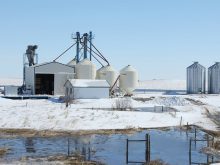SOUTHEY, Sask. – Trent and Sandy Larson have no regrets about their decision to start a new life in rural Saskatchewan.The couple sold their acreage near Stony Plain, west of Edmonton, a few years ago, quit their jobs and packed up their family in search of greener pastures and a new career.They found both on a small farm near Southey, Sask.The Larsons keep a flock of 300 ewes on 640 acres of land bordering the scenic Qu’Appelle Valley, 45 kilometres north of Regina.They bought the land in 2006 and are hoping to expand their flock to 400 or 500 ewes within the next few years.The transition from Stony Plain to rural Saskatchewan was not an easy one for Trent, a former police officer, and Sandy, an ag business graduate and mother of three.However, Sandy said they never questioned the decision to steer their lives in a new direction.“We definitely had our struggles … but I don’t ever remember thinking to myself that I just wanted to pack up and go back to Stony Plain,” she said.“It was a hard leave for us because (Stony Plain) was my home. It’s where I was raised. My parents were there. (Trent’s) folks were there and we kind of felt like, ‘why tip the apple cart if we don’t have to.’ But we both just felt very strongly that this was something we should do.”The Larsons’ decision was inspired by a chance encounter with three orphaned lambs, which Trent found outside their house after completing a shift as an Edmonton patrol officer.Within a few years, the three orphans – two ewes and a ram – had morphed into a flock of 20 ewes.During that time, the Larsons accumulated basic knowledge about breeding, handling and marketing.Sandy initially shrugged off the idea when Trent suggested, tongue in cheek, that they should quit their jobs and become full-time sheep producers.However, the notion of moving to a smaller community, raising their family in a quiet environment and pursuing a new career held considerable appeal.The couple arrived in Southey Sept. 1, 2006, with their two children, 20 ewes and a new outlook on life.They soon bought more ewes from a retiring Alberta producer and not long after that, the couple’s third child, Megan, arrived.Sandy said all of the children, Jocelyn, 7, Nolan, 5, and Megan, 2, enjoy the rural lifestyle and love the sheep.Family was a key factor in the Larsons’ decision to leave Alberta.After serving four years on the Edmonton police force, Trent was beginning to feel the impact of a stressful job that involved long, irregular hours.“I was beginning to see that to be a good police officer, it was like having another family.… ” he said.“I could see that if I didn’t make a change, I was going to put in 25 years (as an officer), my kids were going to grow up, life was going to go by and I was going to miss it.”The Larsons have nothing but praise for their new community and new neighbours.Trent, who also had experience in carpentry and renovations, was soon offered part-time work by a local building supply retailer doing home improvement work in the area. The opportunity supplemented the couple’s income and led to new friendships in the community.“Since we arrived, we’ve met some just fantastic people in Southey,” Sandy said. “Everybody just made us feel so at home and so welcome. We really like Saskatchewan.”Moving did come with its challenges. After arriving, the couple upgraded barns, built fences and corrals and renovated the farmhouse.They also had a new well dug and needed hay to get their flock through the first winter.They seeded alfalfa on much of their land the following spring and continued work to get the system of barns and corrals in order.The farm now produces more than enough forage to feed the flock. Excess supplies are sold.Three and a half years after making the jump, the Larsons are beginning to reap the rewards of their hard work. They use an accelerated breeding program with ewes lambing three times every two years.Lambing occurs three times a year, in mid- December, late March and August.Most lambs are sold as feeders when they reach 70 to 80 pounds.With 300 ewes in the accelerated program, the couple can expect to market 700 to 800 lambs in a calendar year.The Larsons admit that their decision to get into commercial sheep production could not have come at a more opportune time.Demand for lamb has been increasing steadily over the past few years, and Canadian production has not been expanding. As a result, prices are high and margins are good.Good returns have presented unique challenges for Canadian sheep producers, especially when it comes to keeping lambs for flock replacements.Trent, who serves as a director on the Saskatchewan Sheep Development Commission and the Canadian Sheep Federation, said industry expansion is one of the biggest issues facing the industry.With demand growing rapidly, producers are struggling to provide adequate supplies.High prices can tempt producers to deviate from herd expansion strategies, he said.“It’s tempting to sell everything, but there are consequences,” he said.“You can get away with it for two years, maybe three, but then the ewes in your flock are getting older, you’ve got no replacements coming in and you’ve got that huge gap in production, so if you don’t watch it, you’re in for wreck. For us … for the healthy longevity of our flock, we try to keep some back every year.”
Read Also

Communication key to bridging generation gap
Each generation is shaped by the predominant forces at play during their formative years. Acknowledging these influences can improve communication among the generations.















